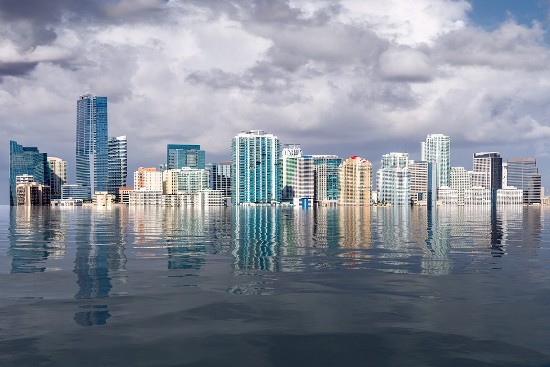When a California wildfire wiped out the community of Paradise in 2018, it came as a consequence of poor decision-making by those who choose to live in high-risk climate change zones. Not every home and building burned to the ground. Approximately 10% remained standing and largely untouched. When the people who owned or rented these properties went to renew insurance coverage, the companies issuing the policies denied them. For those who lost their homes, California law allowed them to renew their policies for two years. The insurance companies could have raised the policy rates for those still standing, but didn’t. That would have made sense considering Paradise by any definition is located in a high-risk wildfire zone, an increasing phenomenon as Americans further encroach on nature. In California, that means living right next to tinder-dry environments that are at extreme fire risk.
Whereas reinsurance companies, who underwrite the insurance industry to give the latter protection on issuing policies have an understanding of climate change risks, the insurance companies appear to be blindly ignorant and sell policies in places where there is an increased risk of fire and floods from climate change and extreme weather events.
In my country, the insurance industry recently published its latest report entitled, Climate Risks: Implications for the Insurance Industry in Canada. The report notes three driving forces for change:
- Payouts for severe weather damage claims are doubling every five to ten years because people are living in areas of increased climate change risk.
- Citizens groups are becoming more vocal and in some cases suing governments and businesses for contributing to greenhouse gas emissions and for lack of climate change action.
- Transitioning to a low-carbon or net-zero future comes with increased costs affecting the insuring of risk.
None of these three issues are unique to Canada, but rather, a rising challenge everywhere with increasing coastal flood and floodplain risks and extreme weather events on the rise. The report links these risks to greenhouse gas emissions from human activity over this past century and sees them as having immediate short-term (15 to 25 years), as well as long-term (beyond 50 years) impacts.
High-Risk Consumer Decisionmaking Has Consequences
The trend to live, work and play in areas deemed increasingly to be high-risk zones means the following for the retail insurance industry:
- Premiums will reflect the growing risk by going up.
- Policies may no longer be issued for coverage in high-risk zones.
- Policies that do get issued could exclude coverage related to extreme weather and climate-change risks.
- Governments could impose regulations that protect consumers and make retail insurers offer policy coverage at controlled rates.
- Or governments may become the insurer of record to provide coverage for consumers living, but not moving to high-risk zones.
Insurance companies may find themselves the target of lawsuits and other actions as property owners without coverage take action.
Yesterday, an article written by Eugene Linden in The Guardian looked at the insurance and reinsurance industry and their responses to climate change. He notes that reinsurers have recognized that climate change risk could bankrupt the industry. But retail insurers, he states, have largely ignored it.
Retail insurers either deny coverage after initial payouts for an extreme weather event or end coverage to existing customers at the time of renewal. For the wealthy, the rising cost of insuring a property is probably manageable. But for the middle and working classes, it is not.
As in the case of California, some governments are becoming insurers which means taxpayers everywhere are taking on the risk and debt that likely will come from payouts to those who choose to live in high-risk zones.
Linden notes that Americans (Canadians too) aren’t changing behaviour. They continue to be shielded from the consequences of their actions. His evidence, “since the climate risks surfaced, millions of people have moved into wildfire zones in the US west and to coastal properties at risk of hurricanes, storm surges and sea-level rise. That influx of people continues, even though the Florida coast has eight of the 20 cities in the US most threatened by sea-level rise.”
Linden blames retail insurers for mispricing climate risk and leading consumers down a risky path. The likely end to this will be a property and banking crisis and meltdown even worse than the mortgage financial crisis of 2008. Why worse? Because extreme weather from global climate change will only escalate as the century unfolds raising costs even further.
So What to Do?
Putting a global price on carbon similar to what Canada has implemented can alter some aspects of our behaviour. It can influence our next car purchase to buy or lease electric. It may change our energy usage. It may make us more discriminating shoppers. But will it stop many from continuing to move closer to nature and coastlines? Not likely.
What will then? Our policymakers need to expand and protect wilderness areas from human encroachment. They need to enact policies to adapt settlement patterns to address sea-level rise and inland flooding. They need to invent policies that encourage citizens to move from areas that will likely be inundated in the next several decades and beyond.
For urban centres that have large populations, policymakers need to fund engineering solutions to elevate, put barriers in place, and redesign coastal cities to adapt to sea-level rise and storm surges. And along other coastlines away from cities they need to restore wetlands and other natural barriers.
Finally, whatever actions we take, need to be universally applied because the impacts of climate change will not stop at national boundaries.
















